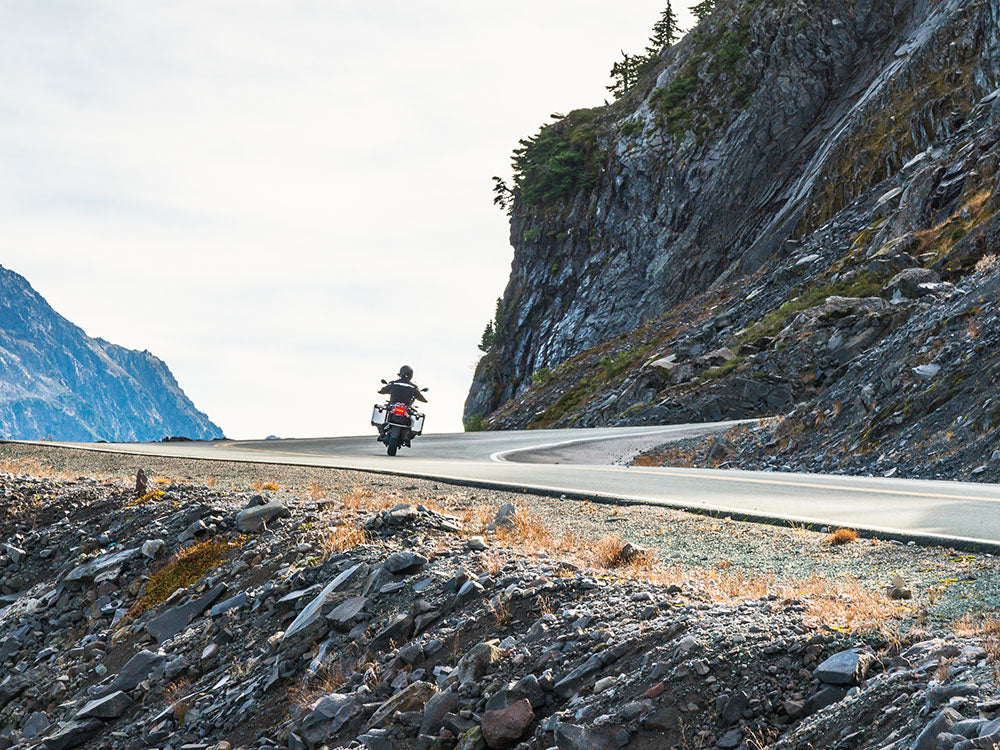Table of Content
1. Introduction
It hardly matters whether you consider yourself an exceptional or an average motorcyclist, everyone is held liable to motorcycle laws. Nobody wants reckless thrill-seekers to be the ones allowed to operate motorcycles. The highways would be a lot more dangerous for drivers and pedestrians if that were the case. Luckily, some guidelines explain in detail what riders are allowed to do and what kind of dangerous behavior they should avoid.
If you live in Alaska or frequently visit the state, this article will list the Alaska motorcycle laws and licensing information so you can better memorize it all.
2. Alaska Motorcycle Insurance

Whether due to inattention on your part or another driver’s, accidents can happen unexpectantly. If you are lucky, you get up relatively unscathed. But in a worst-case scenario, you, the other driver, and your vehicles may be seriously damaged.
Since the costs related to bodily injury and property damage can be worth thousands of dollars, you need Alaska motorcycle insurance to help pay off the brunt of these fees. It is illegal to operate a motorcycle without Alaska motorcycle insurance, resulting in your driver’s license being suspended.
The higher the monthly or annual rate for the Alaska motorcycle insurance plan you choose, the greater coverage it will provide. As bodily injuries and property damage are the main concerns of accidents, you must at least pay for the following:
- $50,000 for bodily injury to a person per accident
- $100,000 for bodily injuries to multiple people per accident
- $25,000 for property damages sustained per accident
Though it is rare to get into too many accidents if you operate a motorcycle responsibly, you may notice the circumstances of each accident may be different. You may encounter drivers with less motorcycle insurance than you or the damage to your motorcycle can range from moderate to severe.
- Uninsured coverage
- Underinsured coverage
- Collision coverage
- Comprehensive coverage
3. Alaska Motorcycle Helmet Laws

In Alaska, if you are 17 years old or below, you have to wear an approved motorcycle helmet for your protection. If you are 18 years old or older, you will not be penalized for not wearing a motorcycle helmet so long as you have proof confirming you are an adult.
You have a wide selection of motorcycle helmets to choose from, each of them differing based on their design. A half helmet covers the top of the head, leaves the face and neck exposed, and offers the least protection. The three-quarter helmet has an outer shell that extends towards the back of the neck, offering moderate protection. And the full-face helmet covers the entire head with a slight opening you can see, offering the best protection.
| Alaska Motorcycle Helmet Laws Chart | |||
|---|---|---|---|
| Requirements | Half Helmet | Three-Quarter Helmet | Full-Face Helmet |
| Has the Department of Transportation (DOT) sticker | ✔ | ✔ | ✔ |
| Contours around your head to fit snugly due to comfort padding | ✔ | ✔ | ✔ |
| No signs of damage (Ex:// cracks, loose padding, scratches, or frayed straps) |
✔ | ✔ | ✔ |
| Has a face shield with no scratches | X | X | ✔ |
| Includes separate eye protection with no scratches (Ex:// goggles, glasses) |
✔ | ✔ | X |
| Has a hard and durable outer shell that is shatter-resistant | ✔ | ✔ | ✔ |
| Has a thick impact-absorbing inner liner | ✔ | ✔ | ✔ |
| Gives you a clear, peripheral view of your surroundings | ✔ | ✔ | ✔ |
| Securely fastened with neck- or chin-strap | ✔ | ✔ | ✔ |
| Allows airflow without fogging up | ✔ | ✔ | ✔ |
| Can allow you to wear sunglasses underneath | ✔ | ✔ | ✔ |
4. Alaska Motorcycle License Laws

4.1 Alaska Motorcycle Instruction Permit
You are ready to receive an Alaska motorcycle instruction permit if you are at least 16 years old or above. After paying a fee of $15, you will be given an Alaska motorcycle instruction permit valid for at least two years.
If you complete the conditions for receiving an Alaska motorcycle instruction permit listed below, you will have taken the first step towards getting a full license.
-
If you are under the age of 18:
- Have signature and consent from a parent or legal guardian
- Present identification documents
- Provide proof of Alaska residency
- Provide proof of U.S. citizenship
- Provide your Social Security Number
- Take a photo
- Pass the knowledge exam
- Pass the vision exam
- Pay the required fees
Since an Alaska motorcycle instruction permit tends to be used by first-time motorcyclists or young adults, there are restrictions in place to keep them from trying maneuvers beyond their current capabilities.
- You cannot transport passengers
- You can only operate during daylight hours
- You must be supervised by a 21-year-old holding a valid motorcycle license
4.2 Alaska Motorcycle License
If you finish practicing with the Alaska motorcycle instruction permit early, it is possible to get an Alaska motorcycle license when you are 16 years old. You can also just apply for the Alaska motorcycle license right away as an adult. Regardless of age, you must pay a fee of $20 to be issued an Alaska motorcycle license valid for five years.
| Alaska Motorcycle License Chart | ||
|---|---|---|
| Requirements | Applicants Ages 16 to 17 |
Applicants Ages 18 and Above |
| Have a valid Alaska motorcycle learner’s permit | ✔ | ✔ |
| Held onto an Alaska motorcycle learner’s permit for at least six months | ✔ | X |
| Complete a Basic Driver Education course | ✔ | X |
| Complete a Motorcycle Safety Foundation course | ✔* | ✔* |
| Provide proof of Alaska motorcycle insurance | ✔ | ✔ |
| Provide proof of Alaska vehicle registration | ✔ | ✔ |
| Fill out the appropriate driver’s license application | ✔ | ✔ |
| Must have the consent of a parent or legal guardian if you are a minor | ✔ | X |
| Provide your social security number | ✔ | ✔ |
| Pay required fees | ✔ | ✔ |
| Present valid photo I.D. | ✔ | ✔ |
| Take a photo | ✔ | ✔ |
| Take vision exam | ✔ | ✔ |
| Pass the knowledge test | ✔ | ✔ |
| Pass the road skills test | ✔* | ✔* |
| Provide proof of U.S. citizenship | ✔ | ✔ |
| Provide proof of residency in Alaska | ✔ | ✔ |
*It is possible for applicants that are 14 years old to apply for an Alaska motorcycle instruction permit with parental consent.
*Applicants that complete a Motorcycle Safety Foundation course and submit a Certificate of Completion to the DMV have the option of waiving the road skills test.
4.3 Alaska Motorcycle License Test
Written Portion:
- Will be completed on touch-screen computers
- Complete 25 multiple-choice questions
- Questions will be based on content from the Alaska Motorcycle Operator Manual
- Will be tested on an understanding of road rules and safe riding practices
- Requires a passing grade of 80% or higher
Road Skills Portion:
- Will be conducted in a controlled, off-street area
- Your motorcycle will be subjected to a pre-ride inspection to ensure it meets safety standards
- Demonstrate a basic understanding of motorcycle operation
- You will be tested on your ability to stay within the speed limit, adjust speed and position, maintain visibility, operate under stress, accelerate, brake, turn, stop, and swerve
- The examiner will grade you based on how well you ride at safe speeds, stay within the lanes, and demonstrate riding maneuvers
5. Alaska Motorcycle Passenger Laws

Alaska has no minimum age requirement for motorcycle passengers. If your motorcycle passenger is below 18 years old, it is required that s/he strap on any of the types of motorcycle helmets mentioned earlier.
Unless the driver’s seat is designed to fit two people, the passenger seat will have to be attached separately. A sidecar is the most secure since it encompasses the lower body, but a rear pillion offers greater freedom of movement. Plus, the latter offers ways for passengers to maintain their grip by making use of handholds and footrests.
Even if no motorcycle laws are in place to prevent you from taking on a passenger of a specific age group, that does not mean you should. A motorcycle passenger should be barely noticeable and make a conscious effort to make a trip as painless as possible.
- Your passenger must be able to reach the footrests
- Your passenger must wear an approved motorcycle helmet
- Your passenger can understand and follow your directions
6. Alaska Lane Splitting Laws

As of 2022, lane splitting is not permitted in Alaska.
Even if there is space between vehicles that have stopped or atop the dotted white lines on roads, you cannot maneuver your motorcycle in either situation.
You cannot try to pass or share the same lane with a car if it takes up all the space within the lane. However, you can lane share with another motorcycle.
7. Alaska Motorcycle Equipment Requirements
For motorcyclists who live in Alaska, it is recommended you bring your motorcycle to a state-approved inspection station at least once a year.
Even if fixing your motorcycle is a dirty and time-consuming job, patching up or replacing the equipment listed below will save you a lot of grief in the long run:

- Horn
- Wheels
- Tires
- Handlebars
- Front and Rear Brakes
- Reflectors
- Controls
- Headlight
- Taillight
- Brake Light
- Turn Signals
- Exhaust System
- Muffler
- Rearview Mirrors
8. Sources
- Alaska Motorcycle Operator Manual
- Alaska Division of Motor Vehicles - Mandatory Insurance
- The Alaska State Legislature - Equipment on Motorcycles, Motor-Driven Cycles, and Bicycles
- Alaska Division of Motor Vehicles - Motorcycle License
- Alaska Division of Motor Vehicles - Fees for Driver Licensing
- The Alaska State Legislature - Applicability of regulations to motorcycles
- The Alaska State Legislature - Driving motorcycles and motor-driven cycles on roadways laned for traffic
- The Alaska State Legislature - Other equipment













Leave a comment
All comments are moderated before being published.
This site is protected by hCaptcha and the hCaptcha Privacy Policy and Terms of Service apply.